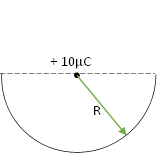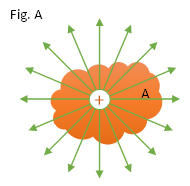
A charge of 10μC is placed at the centre of a hemisphere of radius R = 10 cm as shown. The electric flux through the hemisphere (in MKS units) is

A. ${6 × 10^5}$
B. ${12 × 10^{15}}$
C. ${9 × 10^6}$
D. ${6 × 10^8}$
Answer
218.4k+ views
Hint:As we know, the number of electric field lines (i,e. magnitude) that pass through or intersect a particular area/volume is electric flux. As we know the formula for electric flux passing through a sphere, so we can use it for the hemisphere also by dividing it by 2.
Formula used:
Electric flux through the hemisphere ${\phi=\frac{1}{2}\frac{q}{\varepsilon_0}}$
Complete answer:
As we know, according to the Gauss Theorem; The total electric flux in a closed surface is equal to the charge enclosed in that body divided by permittivity. The electric flux is directly proportional to the net charge applied to the volume of the closed body.
As we can see in fig. A, the electric lines in the body A are only once considered for the electric flux, not the outer ones.
The electric flux is denoted by the ϕ.
Given,
${q = 10μC = 10 × 10^{‒6}} C$
${ {ε_0} = 8.854 × 10^{‒12} {\dfrac{C^2}{N {m^2}}} }$
Now according to the question electric flux is passes through the hemisphere –
Now as we know,
Electric flux through the sphere ${[ \phi=\frac{q}{\varepsilon_0} ]}$
Electric flux through the hemisphere ${\phi=\frac{1}{2}\frac{q}{\varepsilon_0}}$
${\phi=\frac{10\times{10}^{-6}}{2\times 8.854\times{10}^{-12}}}$
${\phi=0.564\times{10}^{-6+12}}$
${\phi=0.6\times{10}^6}$
${\phi=6\times{10}^5}$
So, the electric flux through the hemisphere of radius R = 10 cm is ${6 × 10^5} $
Thus, Option (A) is correct
Note: According to Gauss's law of electricity, the net electric charge q enclosed by any closed surface has a direct relationship to the electric flux over that surface. By remembering the formulas for basic symmetric surfaces one can solve the questions for different other surfaces also.
Formula used:
Electric flux through the hemisphere ${\phi=\frac{1}{2}\frac{q}{\varepsilon_0}}$
Complete answer:
As we know, according to the Gauss Theorem; The total electric flux in a closed surface is equal to the charge enclosed in that body divided by permittivity. The electric flux is directly proportional to the net charge applied to the volume of the closed body.

As we can see in fig. A, the electric lines in the body A are only once considered for the electric flux, not the outer ones.
The electric flux is denoted by the ϕ.
Given,
${q = 10μC = 10 × 10^{‒6}} C$
${ {ε_0} = 8.854 × 10^{‒12} {\dfrac{C^2}{N {m^2}}} }$
Now according to the question electric flux is passes through the hemisphere –
Now as we know,
Electric flux through the sphere ${[ \phi=\frac{q}{\varepsilon_0} ]}$
Electric flux through the hemisphere ${\phi=\frac{1}{2}\frac{q}{\varepsilon_0}}$
${\phi=\frac{10\times{10}^{-6}}{2\times 8.854\times{10}^{-12}}}$
${\phi=0.564\times{10}^{-6+12}}$
${\phi=0.6\times{10}^6}$
${\phi=6\times{10}^5}$
So, the electric flux through the hemisphere of radius R = 10 cm is ${6 × 10^5} $
Thus, Option (A) is correct
Note: According to Gauss's law of electricity, the net electric charge q enclosed by any closed surface has a direct relationship to the electric flux over that surface. By remembering the formulas for basic symmetric surfaces one can solve the questions for different other surfaces also.
Recently Updated Pages
Young’s Double Slit Experiment Derivation Explained

Wheatstone Bridge Explained: Working, Formula & Uses

Chemical Properties of Hydrogen - Important Concepts for JEE Exam Preparation

JEE General Topics in Chemistry Important Concepts and Tips

JEE Atomic Structure and Chemical Bonding important Concepts and Tips

JEE Amino Acids and Peptides Important Concepts and Tips for Exam Preparation

Trending doubts
JEE Main 2026: Application Form Open, Exam Dates, Syllabus, Eligibility & Question Papers

Derivation of Equation of Trajectory Explained for Students

Hybridisation in Chemistry – Concept, Types & Applications

Understanding the Angle of Deviation in a Prism

Understanding Collisions: Types and Examples for Students

Understanding Atomic Structure for Beginners

Other Pages
JEE Advanced Marks vs Ranks 2025: Understanding Category-wise Qualifying Marks and Previous Year Cut-offs

How to Convert a Galvanometer into an Ammeter or Voltmeter

Understanding Centrifugal Force in Physics

Ideal and Non-Ideal Solutions Explained for Class 12 Chemistry

Degree of Dissociation: Meaning, Formula, Calculation & Uses

Understanding Electromagnetic Waves and Their Importance




